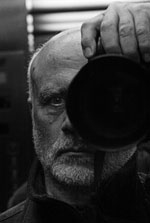

Biography
Ferdiando Scianna
 Ferdinando Scianna (Bagheria, 1943) attended the Faculty of Arts and Philosophy in Palermo, but gave it up to totally devote himself to photography with special attention focused on his land of birth, its customs and its traditions. Resulting from this is the book Feste religiose in Sicilia (Leonardo Da Vinci, Bari, 1965), visual proof of the collective ritual of religious feasts, published with an essay by Leonardo Sciascia and conferred the Nadar award for photography. It was precisely at the writer’s house that Scianna came across the two books Images à la sauvette e Les Européens di Henri Cartier-Bresson, who has since then become his ideal theoretical, practical and poetic master. His choice of the photographic medium stemmed from political reasons, from a desire to protest and from an urgent need to narrate.
Ferdinando Scianna (Bagheria, 1943) attended the Faculty of Arts and Philosophy in Palermo, but gave it up to totally devote himself to photography with special attention focused on his land of birth, its customs and its traditions. Resulting from this is the book Feste religiose in Sicilia (Leonardo Da Vinci, Bari, 1965), visual proof of the collective ritual of religious feasts, published with an essay by Leonardo Sciascia and conferred the Nadar award for photography. It was precisely at the writer’s house that Scianna came across the two books Images à la sauvette e Les Européens di Henri Cartier-Bresson, who has since then become his ideal theoretical, practical and poetic master. His choice of the photographic medium stemmed from political reasons, from a desire to protest and from an urgent need to narrate.
He moved to Milan and since 1967 has contributed to the weekly magazine L’Europeo, at first as a photo reporter and afterwards as a special correspondent from Paris, where he lived for ten years.
He joined Magnum Photos upon Henri Cartier-Bresson’s invitation in 1982. Parallel with his professional activity, Scianna carries on his personal research aimed at documenting the folk world that represents, for the author, a way to be reflected in the world, a sort of notebook of visual notes. He characterises his interest in photography as lying in its specificity of being language and documentation at the same time.
He made a name for himself in the world of fashion in the late 1980s with an original approach made up of masterly blend of fashion and reporting.
He published Le forme del caos in 1989. It contained an introduction by Manuel Vazquez Montalban, who noted that Scianna’s eye captures the best disorders in the cities, turning his photographs into metaphors.
Over the years he has published dozens of books in which not only does he go back to investigating the meaning of religious rites with a series of photographs on the pilgrimages to Lourdes (Viaggio a Lourdes, Mondadori, Milan, 1996), but he also takes up new privileged subjects: from Città del mondo (Bompiani, Milan, 1988) and Dormire, forse sognare (Art &, Udine, 1997) on people who sleep to Mondo bambino (Arte e Stampa, Milan, 2002).
In 2002 he published Quelli di Bagheria, exploring the memory of his native town and its inhabitants with texts and photographs. “With this book I tried (…) to dig into, as Sciascia suggested, the dark room of memory through my own photographs, relating verbal fragments about them that in turn are similar to snapshots,” said the artist. He has taken part in many one-man shows and collective exhibitions, including the more recent retrospective Ferdinando Scianna 1963-2006 at the Fondazione Ragghianti in Lucca.



